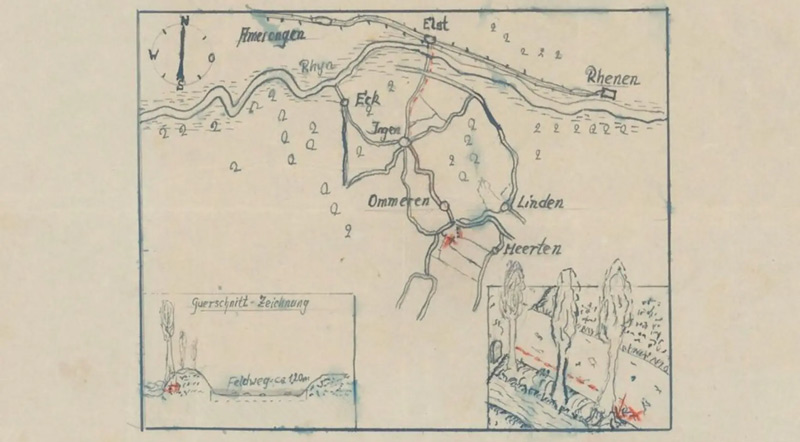
The treasure map, included in documents released by the Dutch national archive, has so far yielded no fortune. [National Archives of the Netherlands]
The location of this cache of coins, watches, jewelry, diamonds and other gems supposedly worth more than C$25 million has been a mystery for almost 80 years. German soldiers stole the hoard from a broken bank vault in Arnhem during the final year of the war and buried it in ammunition boxes as they fled.
Recently, among more than a thousand documents released by the Netherlands national archives, a treasure map has been found with an X evidently marking the spot where the treasure lies buried in what is now a field.
“A lot of researchers, journalists and amateur archaeologists are really interested and excited,” Annet Waalkens, an archives adviser in The Hague, told The Guardian newspaper in what might be the understatement of the New Year.
Indeed, so many treasure hunters armed with shovels, metal detectors and other equipment descended on the town of Ommeren in the Dutch municipality of Buren that local officials asked them to stop their quest.
“Experts point out that the area is close to the frontline of the Second World War,” the municipality said in a statement on Jan. 5. “Searching there is dangerous because of possible unexploded bombs, landmines or grenades. We therefore advise against searching for the Nazi treasure.”
Dutch law stipulates that “archaeological excavations are prohibited, except for organizations with an excavation certificate,” it noted, adding that carrying a metal detector without permission from the municipal executive is also not allowed.
The map originally belonged to a German soldier known only as Helmut S., whose fate is a mystery. After the war, he ended up in Berlin, where he boasted that he was present when the treasure was buried near a poplar tree, though he claimed he was not involved in the original theft.
Helmut S. was subsequently enlisted to help find the treasure and turned the map over to the Dutch government. But over the course of several official and unofficial searches, the hoard was never found.
And it still eludes treasure hunters, apparently. A recent update from the municipality suggested the flood of searchers has left Ommeren.
Experts have speculated that the treasure could have been ransacked by any number of people during the turbulent days at the end of the Second World War—local Dutch villagers, retreating German soldiers or even the country’s Allied liberators.
Tales of Nazi treasure have fascinated and frustrated adventurers and fortune seekers, historians and the public for decades. The Nazis had a history of taking other’s belongings for virtually as long as they existed.
They stole the property of German Jews throughout most of the 1930s and continued plundering beyond their own borders until the war ended.
The Nazis looted about 20 per cent of the art in Europe—more than 100,000 items have not been returned to their rightful owners.
Hitler’s forces took gold, silver, currency, art and cultural treasures as their blitzkrieg swept Europe in 1939-40 and after they took up occupation of some 30 countries and territories for as long as six years. In what has been described as the greatest displacement of art in history, the Nazis even set up organizations and programs specifically for the purposes of plunder.
At war’s end, agents of the Allied Monuments, Fine Arts and Archives program, known as the Monuments Men, recovered vast numbers of looted artworks and other treasures, many of them from more than 1,050 repositories in Germany and Austria, including abandoned mines.
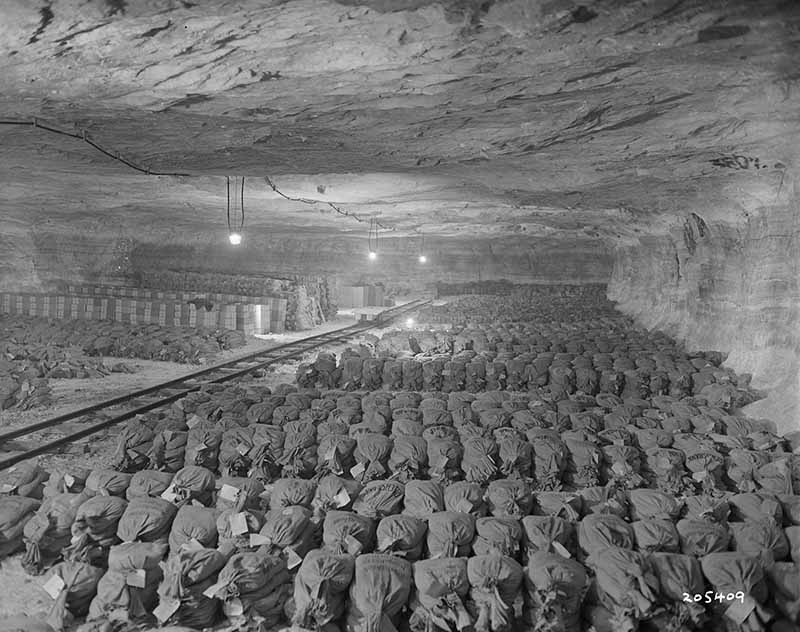
Nazi gold stashed in Germany’s Merkers salt mine.[Cpl. Donald R. Ornitz/American Commission For the Protection and Salvage of Artistic and Historic Monuments In War Areas/Wikimedia]
In March 2022, the British Express newspaper examined claims from the late treasure hunter Roger Miklos, who insisted for four decades that he had found the wreckage of a lost U-boat he described as a mass grave of Nazi officials packed with so much looted gold and artifacts that it “beats Tutankhamun and anything else.”
Miklos died in 2018 without ever revealing the exact location of his purported find, but he left behind a hoard of cryptic documents that believers say point to its location. His family handed the stockpile over to Mike Fletcher, a diver and explorer who, along with a team of experts, is trying to make sense of it all.
U-boats have been a favourite object of Nazi treasure speculation. Some theorists claim high-ranking Nazis packed their loot into submarines in 1945 and made for Argentina and other safe havens.
Miklos claimed that in the dying days of the war, the Nazis built a specially modified fleet of nine deep-sea, cargo-smuggling vessels for just that purpose. None has ever been found.
In 1993, a team raised a remarkably well-preserved U-534 from its resting place at the bottom of the Kattegat Sea near the Danish Island of Anholt. The sub was rumoured to contain the remains of top Nazis, advanced weaponry for the Japanese war in the Pacific—and gold.
It had left Kiel in May 1945, hours before Hitler’s successor as German chancellor, Admiral Karl Dönitz, ordered the fleet to surrender. It was sunk by a depth charge from a Royal Air Force bomber; 49 of 52 aboard were reported to have survived.
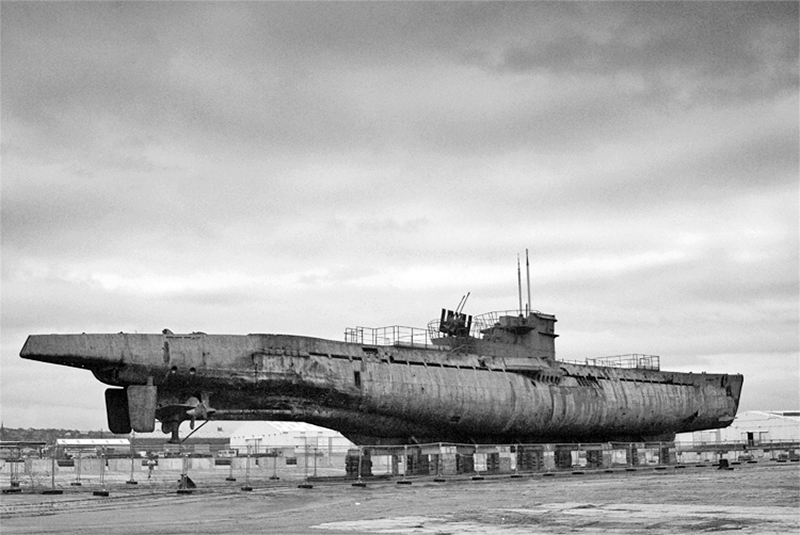
U-534 sits at the Birkenhead Docks in Merseryside, England.[Paul Adams/Wikimedia]
Schäffer had been tasked to enter the port of Southampton, England, and wreak havoc on Allied shipping.
The U-boat, intact but for a piece of the stern section where it had taken a direct hit, was floated on a giant pontoon from Denmark to a private collection of warships in Wirral, England. It has been displayed at Birkenhead docks in Merseyside for nearly two decades, one of four preserved U-boats in the world.
At least two U-boats are known to have made the trip to Argentina, though unsubstantiated rumours about what they might have taken there abound.
Commanded by Oberleutnant zur See Heinz Schäffer, U-977 had set out on its first war patrol three days before Dönitz, who commanded the U-boat fleet for most of the war, ordered his subs to stand down.
Schäffer had been tasked to enter the port of Southampton, England, and wreak havoc on Allied shipping. With the war’s end, however, he opted to make a run for it rather than face what the Nazi propaganda minister, Josef Göbbels, warned would be sterilization and enslavement by the Allied victors.
U-977 offloaded 16 crew who wanted to return to their homes, then sailed for Argentina. It didn’t arrive until August, raising questions about where it had been and what it had been up to in the interim. The crew surrendered to Argentinian authorities, who promptly handed them over to the Americans. U-977 was seized and sunk.
Among the stories surrounding U-977 was one that it had made a secret voyage to Antarctica. Its destiny was an object of skepticism, and rumours were inextricably linked to U-530, whose postwar movements all but mirrored those of U-977.
Oberleutnant zur See Otto Wermuth had skippered U-530 since mid-October 1942, sinking two ships on the boat’s first war patrol. The sub was on its seventh outing when the war ended. Wermuth jettisoned the boat’s five remaining torpedoes, anti-aircraft ammunition, secret papers and his logbook, then made for Mar del Plata, where he and his crew surrendered to Argentinian authorities.
Wermuth never explained why it had taken him more than two months to reach the port, why the submarine had jettisoned its deck gun, or why the crew carried no identification.
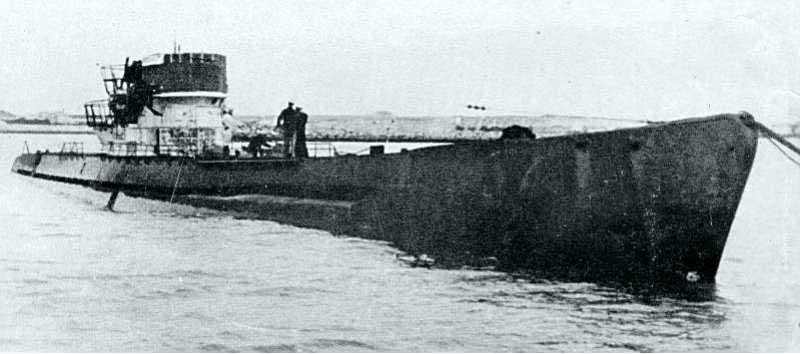
An Argentine Navy boarding party inspects U-530 in July 1945.[Wikimedia]
The Bahia sank in an explosion during sea exercises on July 4, 1945, two months after hostilities officially ended. The incident was ultimately determined to have been an accident after an anti-aircraft gunner aimed too low and hit a stockpile of depth charges on the ship’s stern. Only a handful of the crew survived.
No proof of the U-boats’ complicity has ever been found.
The armoured train has been said to contain the full range of treasure, including art, money and other valuables, on top of some 300 tonnes of gold.
U-boats haven’t been the only means by which lost Nazi loot is said to have disappeared.
In southwest Poland, rumours of a “Nazi gold train” have persisted for decades. The moniker is a bit misleading, since the armoured train has been said to contain the full range of treasure, including art, money and other valuables, on top of some 300 tonnes of gold.
The gold is thought to have come from the Reichsbank in Wrocław, and has been estimated to be worth billions of euros.
All of this was said to have been in a sealed-up rail tunnel or coal mine in the Central Sudetes by retreating Nazis.
The train was said to have left Breslau (now Wrocław) and arrived at the station Freiburg in Schlesien (Świebodzice), but never arrived at the next station in Waldenburg (Wałbrzych). Believers suspect it entered an abandoned coal mine or tunnel system under Książ Castle, part of a top-secret Nazi construction project in the Owl Mountains.

One of the unfinished tunnels of Project Riese in the Owl Mountains, Lower Silesia, Poland.[Wikimedia]
Historians have said it has never been proven that the train even existed. During the Polish Communist regime, military conducted searches, but never found any signs of a train.
The story was revived between 2015 and 2018 when two men claimed to have discovered it using ground-penetrating radar. Piotr Koper of Poland and Andreas Richter of Germany, co-owners of the mine exploration company XYZ S.C., secretly negotiated a finders’ fee of 10 per cent of the value of the train’s contents in return for providing the Polish government with information leading to its location.
The Polish deputy culture minister announced that the pair’s ground-penetrating radar images confirmed with 99 per cent probability that a 100-metre-long train had been found.
Three days later, however, the area governor told reporters their documentation was suspect: “There is no more proof for this alleged discovery than for other claims made over the years.”
A dig involving Polish military, state officials and privately funded individuals was halted after the anomaly Koper and Richter had detected was found to be geological.
The pair continued to pursue their quest until Richter left the excavation team in August 2018. Koper planned to continue. He never did find Nazi gold, but in January 2019 he discovered several priceless 16th-century wall paintings hidden behind plaster while renovating an old palace in a Polish village.
The legend lived on as a tourist attraction in the form of a full-size replica of a Nazi armored train.
The region of Lower Silesia where the train stories flourished is a hotbed of all kinds of Nazi treasure lore. It’s riddled with caves, mines and tunnels, as well as castles, palaces and dungeons—all of which ostensibly offered Nazi treasure hoarders plenty of places to hide their ill-gotten gains.
In 2019, a secret society in Germany is said to have turned over an old diary to a Polish foundation, Silesian Bridge. Allegedly written 75 years ago by a Waffen SS officer using the pseudonym “Michaelis,” the journal outlined plans by the Nazi architect of the Holocaust, Heinrich Himmler, to hide stolen riches.
It listed 11 sites where it said Nazis concealed looted gold, jewels, priceless paintings and religious objects. The sites included an abandoned well that extends nearly 60 metres beneath the 16th-century Hochberg Palace in the Polish village of Roztoka. The palace once housed a Nazi brothel.
The gold is thought to have come from the Reichsbank in Wrocław and has been estimated to be worth billions of euros.

The 16th century palace was owned by the artistocratic Hochberg family.[Marek Szadkowski, Wikimapia]
Alas, historians recently declared the document a Polish-German forgery likely produced sometime after 1982.
“The result of our analysis unequivocally identifies the war diary as a fictional text created many years after the war,” said Łukasz Orlicki, a historian with the Discoverer group, which carried out a critical source analysis on the diary contents.
Orlicki said the journal itself is an accounting book from the turn of the 20th century. Most of its nearly 600 pages are empty. The notes referencing the hidden valuables and artwork, which accompany some general war history from the region, cover only nine pages and were written in pencil.
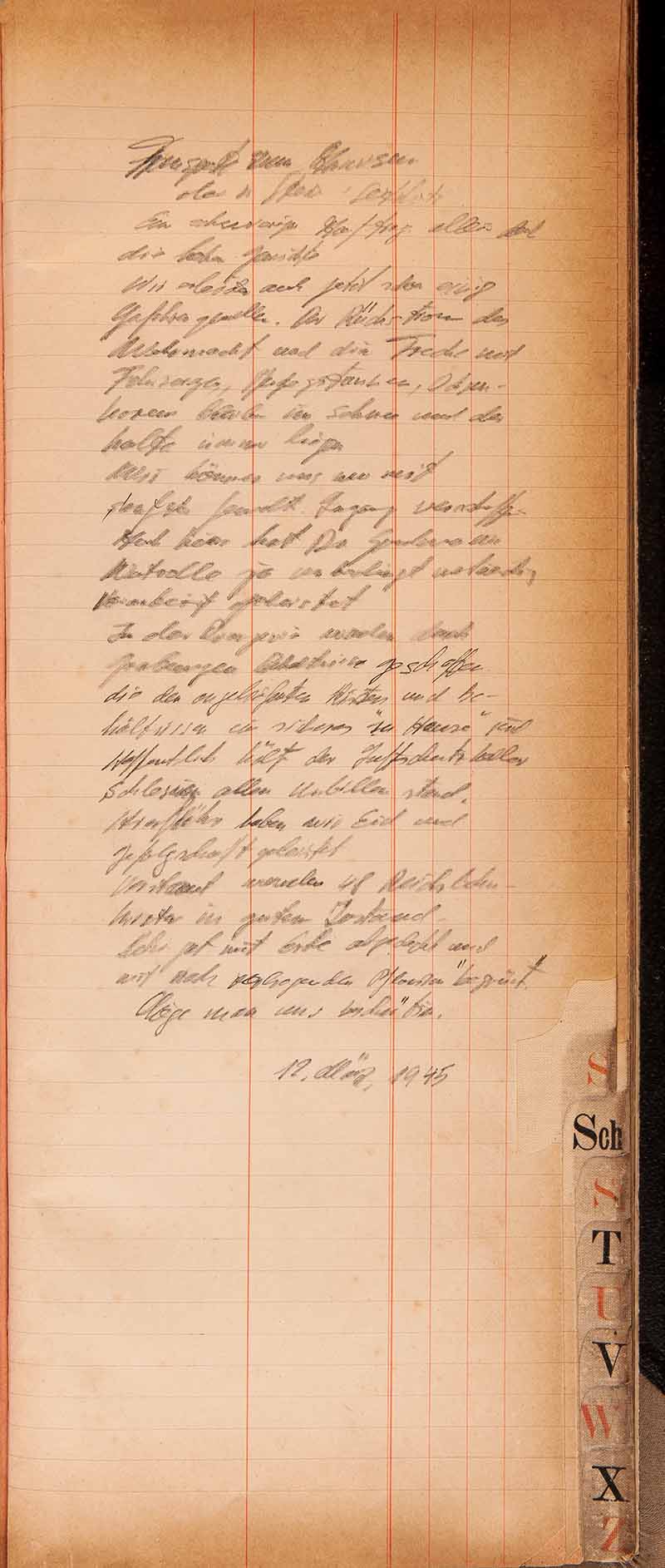
The notes containing information about the hidden valuables and artwork cover only nine pages and were written in pencil.[Silesian Bridge Foundation]
Among the few people named is a mysterious character, Ollenhauer, who is depicted as the organizer of the treasure operation.
The same name appeared in newspaper articles from the 1970s and ’80s about the Nazi gold train. It had different spellings until writers settled on “Ollenhauer” in 1982—the reason Orlicki believes the diary was likely written after 1982.
Advertisement





























